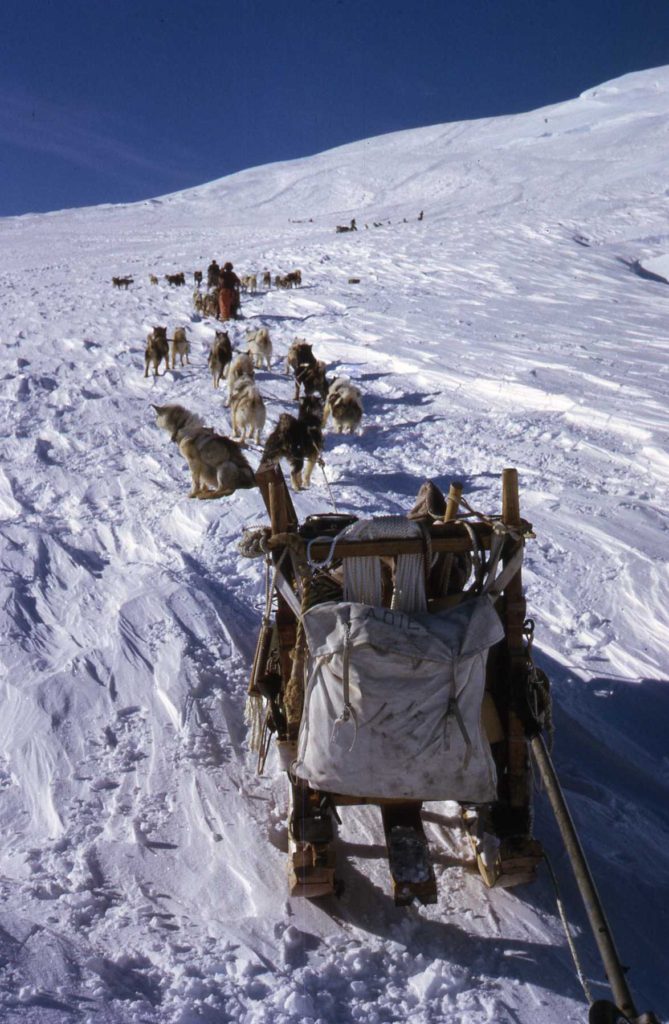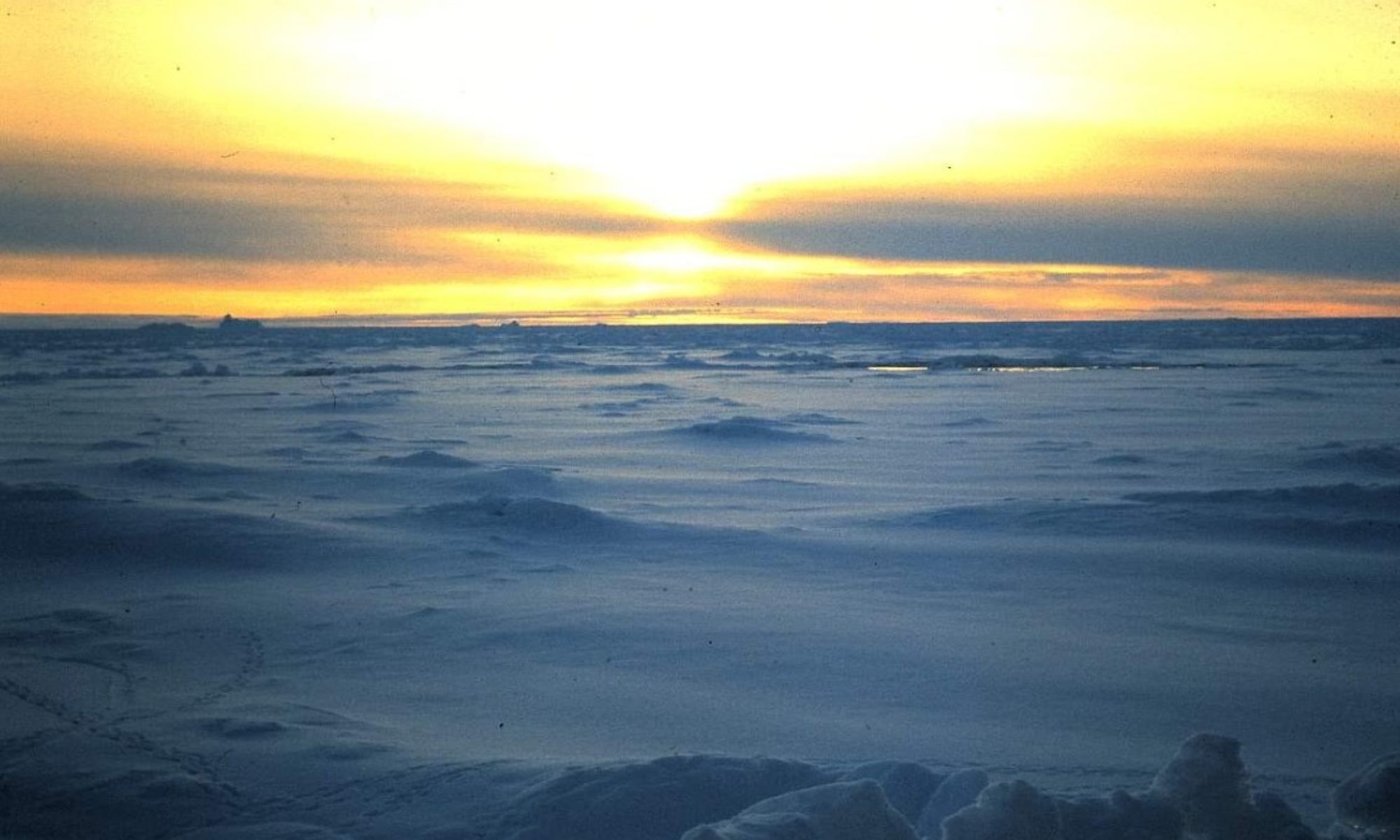My Introduction to Dog Sledging (continued)
My Introduction to Dog Sledging – Dave Burkitt

On the 23rd of April, 1973, eight teams set out from Stonington in an impressive looking convoy up the N.E Glacier. For half of the drivers it was their first taste of Antarctic dog sledging, for all of us it proved to be a memorable one.
It was Autumn, the days were getting shorter and the weather more unsettled, long periods of temperatures in the minus 20’s, whiteout and drifting snow from the strong winds which constantly blew down off the plateau. The work to be done was geology, geophysics and for four of us , to tie in the final angles and measurements of the mapping survey.
All of us spent the first period of 14 days to the north of the N.E. Glacier, the route which took us from Stonington Island and eventually to reach the Plateau via the Sodabread route. The surveyors during this time managed to get one day when the wind and snow eased sufficiently to allow us to work – the rest of the time was spent travelling and lying up waiting.
Continuing from Stonington 1973…
Having completed this bit of work, John Yates, surveyor, with the Picts and myself with the Admirals then headed back for Sodabread. We spent several days waiting for reasonable weather to get up onto the Plateau. Eventually, assisted by three other teams, we relayed our supplies up to The Amphitheatre and at last up onto the top. John and I then said farewell to the others and we pressed on to Armadillo Hill where we camped just as it was getting dark.
The next two days we sledged south, to Beehive Depot then on down the Wyatt Glacier, all fairly uneventful apart from a frightening few minutes when the Admirals took off, minus myself trying embarrassingly to get my skis on. John gave chase for nearly a mile before he caught them still heading for the steep drop of 1,000ft down to the Neny Glacier.
On the 11th May we camped, position 68 20′ S 66 16’W. The wind was a steady 30kts from the NE. Visibility down to 50 yards and the thermometer reading -26 degrees C. We were an hours walk beneath the ‘Sentinel’ survey station which needed to be linked in with ‘Grandstand’ some 20 miles to the north.

The next 16 days seemed endless. The tent always drumming in the wind, white out conditions, freezing cold, poor radio communications, and lying in our damp sleeping bags which were forever being showered by the falling frost which lined the inside of our tent.
On the 17th and 20th May the weather improved sufficiently to allow John to use the telurometer and also measure horizontal and vertical angles to two other stations, though he did at one point get blown off the ridge by a strong gust.
From then until the 27th we lay up, slowly running out of fuel, man food and dog food. The dogs, already under nourished, were by then on 1/2 of nutty each. On the 27th the wind was gusting about 30 kts, but the visibility had improved. Things were getting serious and so we decided to make a move. We packed up and were away on a compass bearing. By 6.0 clock, in the dark, we could just make out the shape of Beehive Hill, but could not find the depot and so we camped. The dogs were fed 1/2 a bar of manfood each.
The next day we groped around in the mank outside. We found that we were on a spur running west to east, dropping away sharply some 50 yards on either side – back to the tent we went! Again the following day the wind had dropped, the visibility was poor and it was snowing lightly, so we got out of the tent and armed with anything that would act as a marker we walked by compass to the south west, leaving a line of ski poles, shovels etc. Then suddenly there was a clearance, about a mile away on a bearing of 170 degrees we could see the depot. Hastily we made our way back to the tent, dropped camp, and were away again.
Unfortunately, Enna, one of the Picts couldn’t move and had to be carried. As soon as we had re-camped we got her into the tent and tried to revive her. Bob Bostlemann, the vet, advised us over the radio, and we tried to get sugar and water into her. Sadly she died of exposure an hour later. Over several hours that evening we gave the dogs several feeds. They had all served us well.
For my part I remember a real treat was some dehydrated fish which we’d never had in manfood before; we boiled it in milk powder and water and it was beautiful!
We then had three days lie-up, no worries, plentiful food and fuel, the primus was going full belt all day, drying out our gear. Outside the temperature was -33 degrees C and the usual 30 knot wind. Inside our pyramid tent, life was sweet!
On the 2nd June we packed up and made our way north for the return journey back to base. It was by no means plain sailing though, the strong winds of the past few days had created some very big sastrugi, particularly round the slopes of Armadillo Hill where our sledges were capsizing every few yards.
We got to the top of Sodabread but in the thick pea soup mank we couldn’t find the marker pole and had a further lie-up. On the morning of the 5th. Stonington had given us a good weather report and we were soon ready to go. We located the marker pole which had been snapped off in the high winds. We deposited surplus food and fuel and made ready for the steep descent by fixing rope and chain brakes to the sledge runners.
John led off. The route was frightening, ice hard sastrugi as big as surf rollers. The sledges kept getting thrown over, then the brake on my sledge snapped clean off, I was hanging on, willing my sledge to slow down, it hit a large bump, turned and I was catapulted head first over the handlebars and 30′ down a crevasse.
I must have been knocked unconscious; when I came to I found I was on a hard drifted snow bridge, just a few feet away from the big hole. By then John had picketed his team and was looking down at me. “Don’t move” were his words. He got the rescue gear out and got me to safety. The sledge had stopped, wedged precariously over the lip of the crevasse. I can vividly remember the dogs sitting there as if nothing had happened! We unloaded everything and got the sledge to a safe place before re-loading. The weather had taken a turn for the worse and we decided to try to get down to The Amphitheatre and camp. Sledging wasn’t getting any easier though – the handlebars on my sledge had both been broken off.
I must have been in a state of shock, my chest hurt and I was coughing up spittles of blood. We got the tent up though and sorted out, then John got on the radio. Communications were bad and he couldn’t raise Stonington, but quite by chance Sledge Zulu over on Adelaide Island heard us, Dr Chris Andrews was in the party. He gave medical advice and relayed our position to Stonington.
Next morning, we failed to make radio contact with anyone. While John recced a route down I fitted a new brake and lashed a high load at the back of my sledge to act as handlebars. We got away from The Amphitheatre at midday and made our way down, sledges still capsizing on the big bumps. John’s sledge went over and his handlebars broke off too. Before we got to the bottom we could see four sledges coming up the N.E. Glacier towards us. Two hours later we were at the bottom and met with the others.
They split my team up, towed my sledge and gave me as comfortable a ride as possible sat atop some ‘P’ bags back to base., where we arrived safely in the dark. It turned out that everyone at Stonington had been working well into the night to get gear ready for the rescue – they themselves having just returned from an epic trip in the Trough Glacier, where for several days they had experienced winds in excess of 100 knots causing flying ice to rip the tents apart. But that’s someone else’s story.
The statistics for our trip were :
Days in field 45,
Days travelling 14,
Days surveying 3
Days lie-up 28
Total mileage 115
Dave Burkitt – GA Stonington 1973

